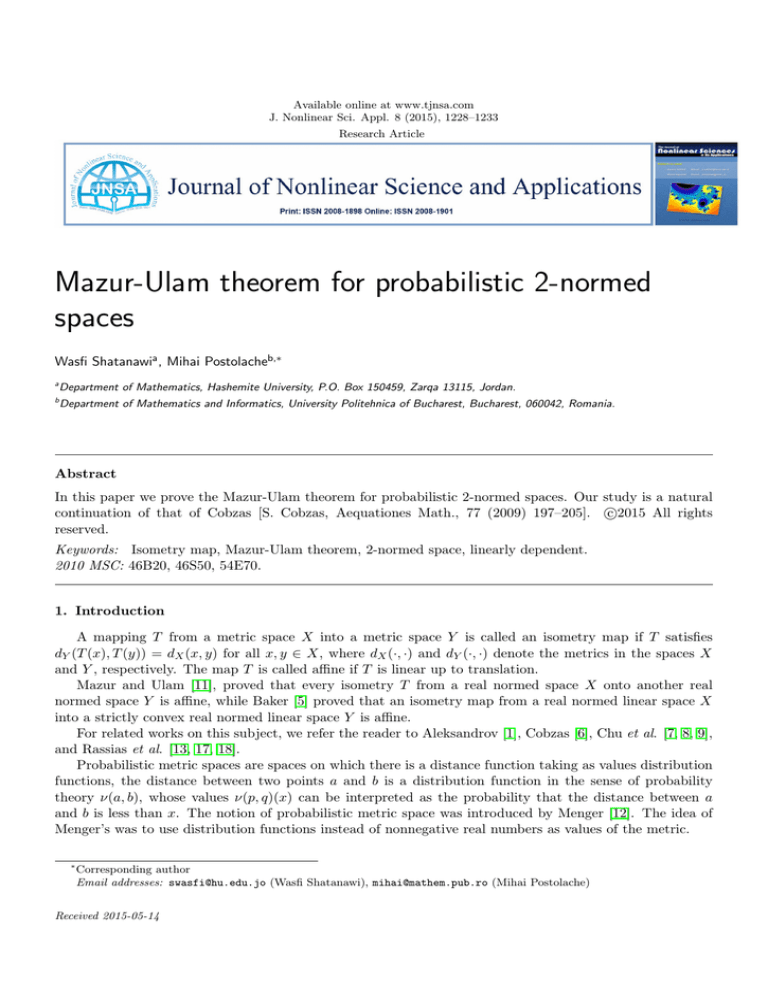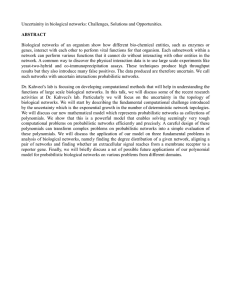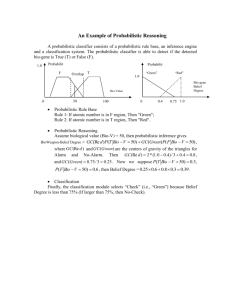
Available online at www.tjnsa.com
J. Nonlinear Sci. Appl. 8 (2015), 1228–1233
Research Article
Mazur-Ulam theorem for probabilistic 2-normed
spaces
Wasfi Shatanawia , Mihai Postolacheb,∗
a
Department of Mathematics, Hashemite University, P.O. Box 150459, Zarqa 13115, Jordan.
b
Department of Mathematics and Informatics, University Politehnica of Bucharest, Bucharest, 060042, Romania.
Abstract
In this paper we prove the Mazur-Ulam theorem for probabilistic 2-normed spaces. Our study is a natural
c
continuation of that of Cobzas [S. Cobzas, Aequationes Math., 77 (2009) 197–205]. 2015
All rights
reserved.
Keywords: Isometry map, Mazur-Ulam theorem, 2-normed space, linearly dependent.
2010 MSC: 46B20, 46S50, 54E70.
1. Introduction
A mapping T from a metric space X into a metric space Y is called an isometry map if T satisfies
dY (T (x), T (y)) = dX (x, y) for all x, y ∈ X, where dX (·, ·) and dY (·, ·) denote the metrics in the spaces X
and Y , respectively. The map T is called affine if T is linear up to translation.
Mazur and Ulam [11], proved that every isometry T from a real normed space X onto another real
normed space Y is affine, while Baker [5] proved that an isometry map from a real normed linear space X
into a strictly convex real normed linear space Y is affine.
For related works on this subject, we refer the reader to Aleksandrov [1], Cobzas [6], Chu et al. [7, 8, 9],
and Rassias et al. [13, 17, 18].
Probabilistic metric spaces are spaces on which there is a distance function taking as values distribution
functions, the distance between two points a and b is a distribution function in the sense of probability
theory ν(a, b), whose values ν(p, q)(x) can be interpreted as the probability that the distance between a
and b is less than x. The notion of probabilistic metric space was introduced by Menger [12]. The idea of
Menger’s was to use distribution functions instead of nonnegative real numbers as values of the metric.
∗
Corresponding author
Email addresses: swasfi@hu.edu.jo (Wasfi Shatanawi), mihai@mathem.pub.ro (Mihai Postolache)
Received 2015-05-14
W. Shatanawi, M. Postolache, J. Nonlinear Sci. Appl. 8 (2015), 1228–1233
1229
Probabilistic normed spaces were introduced by S̃ertnev in 1963 [19]. New definitions of probabilistic
normed spaces were studied by Alsina et al. [2, 3, 4]. It is remarkable that the probabilistic generalization
of metric spaces appears to be well adapted for the investigation of quantum particle physics, particularly
in connections with both string and ε∞ theory, which where given and studied by El Naschie [14, 15].
The notion of the probabilistic n-normed space was introduced by A. Poumoslemi and M. Salimi [16],
while the notion of probabilistic 2-normed space was introduced by I. Golet [10]. In 2009, S. Cobzas studied
the Mazur-Ulam theorem for probabilistic normed spaces [6].
In this paper, we study the Mazur-Ulam theorem for probabilistic 2-normed spaces.
2. Basic Concepts
Denote by 4 the set of distribution functions, meaning, nondecreasing, left continuous functions
ν : R → [0, 1], with ν(−∞) = 0 and ν(∞) = 1. Let D be the subclass of 4 formed by all functions
ν ∈ 4 such that
lim ν(x) = 0 and lim ν(x) = 1.
x→∞
x→−∞
The set of distance functions are
4+ = {ν ∈ 4 : ν(0) = 0}
and D+ = D ∩ 4+ .
It follows that for ν ∈ D+ , we have ν(x) = 0 for all x ≤ 0. Two important distance functions are
0, x ≤ 0;
ε0 (x) =
1, x > 1
and
ε∞ (x) =
0, x < ∞;
1, x = ∞
A triangle function T is a binary operation on 4+ that is commutative and associative, nondecreasing in
each place and has ε0 as identity, that is T (ν, ε0 ) = ν. A t-norm is a continuous binary operation on [0, 1],
that is commutative, associative, nondecreasing in each variable and has 1 as identity. The triangle function
τT associated to a t-norm T is defined by
τT (F, G)(x) = sup{T (F (s), G(t)) : s + t = x}.
In this paper we are interested in the definition of probabilistic n-normed spaces, specially in the case
of n = 2.
Definition 2.1 ([16]). Let X be a real linear space with dim X ≥ n, let T be a triangle function, and let ν
be a mapping from X into D+ . If the following conditions are satisfied:
1. ν(x1 , . . . , xn ) = ε0 if x1 , . . . , xn are linearly dependent,
2. ν(x1 , . . . , xn ) 6= ε0 if x1 , . . . , xn are linearly independent,
3. ν(x1 , . . . , xn ) = ν(xj1 , . . . , xjn ) for any permutation (j1, j2, . . . , jn) of (1, 2, . . . , n)
4. ν(βx1 , . . . , xn ) = ν(x1 , . . . , xn )
s
|β|
, for every s > 0, and β 6= 0,
5. ν(x1 , . . . , xn−1 , xn + y) ≥ T (ν(x1 , . . . , xn−1 , xn ), ν(x1 , . . . , xn−1 , y))
for y, x1 , . . . , xn ∈ X, then ν is called a probabilistic 2-norm on X and the triple (X, ν, T ) is called a
probabilistic 2-normed space.
Definition 2.2. Let X be a real linear space and x, y, z mutually disjoint elements of X. Then x, y and z
are said to be 2-collinear if
y − z = t(x − z),
for some real number t.
W. Shatanawi, M. Postolache, J. Nonlinear Sci. Appl. 8 (2015), 1228–1233
1230
3. Main Results
We start our work by giving the definition of probabilistic 2-normed space.
Definition 3.1 ([10]). Let X be a real linear space with dim X ≥ 2, let T be a triangle function, and let ν
be a mapping from X into D+ . If the following conditions are satisfied:
1. ν(x1 , x2 ) = ε0 if x1 and x2 are linearly dependent,
2. ν(x1 , x2 ) 6= ε0 if x1 and x2 are linearly independent,
3. ν(x1 , x2 ) = ν(x2 , x1 ), 4. ν(βx1 , x2 ) = ν(x1 , x2 )
s
|β|
, for every s > 0, and β 6= 0,
5. ν(x1 + x2 , y) ≥ T (ν(x1 , y), ν(x2 , y))
for y, x1 , x2 ∈ X, then ν is called a probabilistic 2-norm on X and the triple (X, ν, T ) is called a probabilistic
2-normed space.
From now on, unless otherwise stated, we let (X, ν, T ) and (Y, ν, T ) be probabilistic 2-normed spaces.
In our work, we assume that: If x and y are linearly independent elements in X or in Y , then ν(x, y) is
strictly increasing.
The following lemma due to A. Pourmoslemi and M. Salimi [16] is crucial in proving our next result.
Lemma 3.2 ([16]). For x1 , x2 ∈ X and α ∈ R, we have
ν(x1 , αx1 + x2 ) = ν(x1 , x2 ).
The following result is essential for proving our main result.
Lemma 3.3. Let x1 and x2 be any two distinct elements in X, and let
u=
x1 + x2
.
2
Then u is the unique element in X satisfying for all s > 0 the following equalities:
ν(x1 − u, x1 − c)(s) = ν(x2 − c, x2 − u)(s) = ν(x1 − c, x2 − c)(2s)
for c ∈ X where x1 − c and x2 − c are linearly independent and x1 , x2 , u are 2-collinear.
Proof. Choose c ∈ X with x1 − c, x2 − c being linearly independent. For s > 0 we have
x1 + x2
ν(x1 − u, x1 − c)(s) = ν x1 −
, x1 − c (s)
2
x1 − x2
=ν
, x1 − c (s)
2
= ν(x1 − x2 , x1 − c)(2s)
= ν(x1 − c + c − x2 , x1 − c)(2s)
= ν(x2 − c, x1 − c)(2s)
= ν(x1 − c, x2 − c)(2s).
Similarly, we can show that
ν(x2 − c, x2 − u)(s) = ν(x1 − c, x2 − c)(2s).
To prove the uniqueness, assume that w is an element in X satisfying for all s > 0 the equalities:
ν(x1 − w, x1 − c)(s) = ν(x2 − c, x2 − w)(s) = ν(x1 − c, x2 − c)(2s)
(3.1)
W. Shatanawi, M. Postolache, J. Nonlinear Sci. Appl. 8 (2015), 1228–1233
1231
for c ∈ X where x1 − c and x2 − c are linearly independent and x1 , x2 , w are 2-collinear. Since x1 , x2 , w are
2-collinear, there is a scalar t such that w = (1 − t)x1 + tx2 . Hence for s > 0, we have
ν(x1 − w, x1 − c)(s) = ν(x1 − (1 − t)x1 − tx2 ), x1 − c)(s)
= ν(tx1 − tx2 − ct + ct), x1 − c)(s)
= ν(t(x1 − c) − t(x2 − c), x1 − c)(s)
= ν(−t(x2 − c), x1 − c)(s)
s
= ν(x1 − c, x2 − c)
|t|
and
ν(x2 − c, x2 − w)(s) = ν(x2 − c, (1 − t)x2 − (1 − t)x1 )(s)
= ν(x2 − c, (1 − t)x2 − (1 − t)x1 − (1 − t)c + (1 − t)c)(s)
= ν(x2 − c, (1 − t)(x2 − c) − (1 − t)(x1 − c))(s)
= ν(x2 − c, −(1 − t)(x1 − c))(s)
s
= ν(x2 − c, x1 − c)
|1 − t|
s
= ν(x1 − c, x2 − c)
.
|1 − t|
Since w satisfies Equation (3.1) and ν(x1 − c, x2 − c) is strictly increasing, we get that
2=
1
1
= .
|1 − t|
|t|
So we conclude that t = 12 , and hence w = u.
Using similar arguments as in the proof of Lemma 3.3, we can prove the following result.
Lemma 3.4. Let x1 and x2 be any two distinct elements in X. Let
u=
x1 + x2
.
2
Then u is the unique element in X satisfying for all s > 0 the following equalities:
ν(u − x1 , x2 − c)(s) = ν(x1 − c, u − x2 )(s) = ν(x1 − c, x2 − c)(2s),
for c ∈ X where x1 − c and x2 − c are linearly independent and x1 , x2 , u are 2-collinear.
To achieve our main result we introduce the following definition.
Definition 3.5. Let (X, ν, T ) and (Y, ν, T ) be probabilistic 2-normed spaces. We call the map f : X → Y
probabilistic 2-isometry if
ν(f (x) − f (c), f (y) − f (c))(s) = ν(x − c, y − c)(s)
holds, for all x, y, c ∈ X and all s > 0.
Lemma 3.6. Let f : X → Y be probabilistic 2-isometry from probabilistic 2-normed space (X, ν, T ) into probabilistic 2-normed space (Y, ν, T ).
Define the map f from (X, ν, T ) into (Y, ν, T ) by the rule
g(x) = f (x) − f (0). Then f is probabilistic 2-isometry iff g is probabilistic 2-isometry.
W. Shatanawi, M. Postolache, J. Nonlinear Sci. Appl. 8 (2015), 1228–1233
1232
Proof. Assume that f is probabilistic 2-isometry, then for a, b, c ∈ X and s > 0 we have
ν(g(a)−g(c), g(b)−g(c))(s) = ν(f (a) −f (0) −(f (c)−f (0)), f (b)−f (0) − (f (c) − f (0)))(s)
= ν(f (a) − f (c), f (b) − f (c))(s)
= ν(a − c, b − c)(s).
So g is probabilistic 2-isometry.
Similarly we may show that if g is probabilistic 2-isometry, then f is probabilistic 2-isometry.
We have furnished all necessary background to introduce and prove our main result.
Theorem 3.7. Let f : X → Y be probabilistic 2-isometry from probabilistic 2-normed space (X, ν, T ) into
probabilistic 2-normed space (Y, ν, T ) with the property that if a, b, and c are 2-collinear in X, then f (a), f (b),
and f (c) are 2-collinear in Y . Then f is affine.
Proof. By Lemma 3.6, we may assume that f (0) = 0. So it suffices to prove that f is linear. Let x and y
be two distinct elements in X, and u = x+y
2 . Since dim X ≥ 2, there is c ∈ X such that x − c and y − c are
linearly dependent. Now for s > 0, we have
ν(f (x) − f (u), f (x) − f (c))(s) = ν(x − u, x − c)(s)
x+y
=ν x−
,x − c
2
x−y
=ν
, x − c (s)
2
= ν(x − c − (y − c), x − c)(2s)
= ν(y − c, x − c)(2s)
= ν(f (y) − f (c), f (x) − f (c))(2s)
= ν(f (x) − f (c), f (y) − f (c))(2s).
Similarly, we may prove that
ν(f (y) − f (u), f (y) − f (c))(s) = ν(f (x) − f (c), f (y) − f (c))(2s).
By Lemma 3.3, we conclude that
f (u) = f
x+y
2
=
f (x) + f (y)
.
2
(3.2)
For x ∈ X, s > 0, and α ∈ R+ \ {0}, we have
ε0 (s)= ν(αx, x)(s)= ν(αx− 0, x− 0)(s)= ν(f (αx) −f (0), f (x)−f (0))(s)= ν(f (αx), f (x))(s).
So f (αx) and f (x) are linearly dependent. Hence there is k ∈ R such that f (αx) = kf (x). Choose y ∈ X
such that x and y are linearly independent. Then for s > 0, we have
s
ν(x, y)
= ν(αx, y)(s) = ν(f (αx), f (y))(s)
α
s
= ν(kf (x), f (y))(s) = ν(f (x), f (y))
|k|
s
= ν(x, y)
,
|k|
and hence α = |k|.
W. Shatanawi, M. Postolache, J. Nonlinear Sci. Appl. 8 (2015), 1228–1233
1233
Claim: k = α.
If k = −α, then for s > 0, we have
s
ν(x, y)
= ν((α − 1)x, y)(s) = ν(αx − x, y − x)(s)
|α − 1|
= ν(f (αx) − f (x), f (y) − f (x))(s) = ν(−αf (x) − f (x), f (y) − f (x))(s)
s
s
= ν(f (x), f (y))
= ν(f (x), f (y) − f (x))
α+1
α+1
s
= ν(x, y)
.
α+1
So |α − 1| = α + 1, and hence α = 0 which is a contradiction. Therefore k = α and so that f (αx) = αf (x),
for all α ∈ R+ \ {0}.
Similarly, we can show that f (αx) = αf (x) for all α ∈ R− \ {0}. Given two distinct elements x and y in
X. Since
2x + 2y
f (x + y) = f
2
by Equation (3.2), we get that
f (x + y) =
f (2x) + f (2y)
2f (x) + 2f (y)
=
= f (x) + f (y).
2
2
If x = y, then f (x + y) = f (2x) = 2f (x) = f (x) + f (x) = f (x) + f (y). So f is affine.
References
[1] A. D. Aleksandrov, Mappings of families of sets, Soviet Math. Dokl., 11 (1970), 116–120. 1
[2] C. Alsina, B. Schweizer, C. Sempi, A. Sklar, On the definition of a probabilistic inner product space, Rend Mat.
Appl., 17 (1997), 115–127. 1
[3] C. Alsina, B. Schweizer, A. Sklar, On the definition of a probabilistic normed space, Aequationes Math., 46 (1993),
91–98. 1
[4] C. Alsina, B. Schweizer, A. Sklar, Continuity properties of probabilistic norms, J. Math. Anal. Appl., 208 (1997),
446–452. 1
[5] J. A. Baker, Isometries in normed spaces, Amer. Math. Monthly, 78 (1971), 655–658. 1
[6] S. Cobzas, A Mazur-Ulam theorem for probabilistic normed spaces, Aequationes Math., 77 (2009), 197–205. 1
[7] H. Y. Chu, On the Mazur-Ulam problem in linear 2-normed spaces, J. Math. Anal. Appl., 327 (2007), 1041–1045.
1
[8] H. Y. Chu, S. H. Ku, D. S. Kang, Characterizations on 2-isometries, J. Math. Anal. Appl., 340 (2008), 621–628.
1
[9] H. Y. Chu, C. G. Park, W. G. Park, The Aleksandrov problem in linear 2-normed spaces, J. Math. Anal. Appl.,
289 (2004), 666–672. 1
[10] I. Golet, On probablistic 2-normed spaces, Novi Sad J. Math., 35 (2005), 95–102. 1, 3.1
[11] S. Mazur, S. Ulam, Sur les transformationes isométriques d’espaces vectoriels normés, C. R. Acad. Sci. Paris,
194 (1932), 946–948. 1
[12] K. Menger, Statistical metrics, Proc. Nat. Acad. Sci. USA, 28 (1942), 535–537. 1
[13] B. Mielnik, T. M. Rassias, On the Aleksandrov problem of conservative distances, Proc. Amer. Math. Soc., 116
(1992), 1115–1118. 1
[14] M. S. El. Naschie, On the uncertainty of Cantorian geometry and two-slit experiment, Chaos Solitons Fractals, 9
(1998), 517–529. 1
[15] M. S. El. Naschie, On the unification of heterotic strings, M theory and ε∞ theory, Chaos Solitons Fractals, 11
(2000), 2397–2408. 1
[16] A. Pourmoslemi, M. Salimi, Probabilistic n-normed spaces, D-n-compact sets and D-n-bounded sets, Chaos,
Solitons Fractals, 42 (2009), 2729–2734. 1, 2.1, 3, 3.2
[17] T. M. Rassias, On the A. D. Aleksandrov problem of conservative distances and the Mazur-Ulam theorem, Nonlinear Anal., 47 (2001), 2597–2608. 1
[18] T. M. Rassias, P. S̃emrl, On the Mazur-Ulam problem and the Aleksandrov problem for unit distance preserving
mappings, Proc. Amer. Math. Soc., 118 (1993), 919–925. 1
[19] A. N. S̃erstnev, On the motion of a random normed space, Dokl. Akad. Nauk. SSSR, 149 (1963), 280–283. 1






